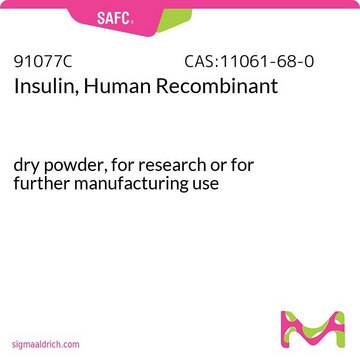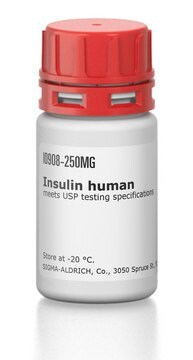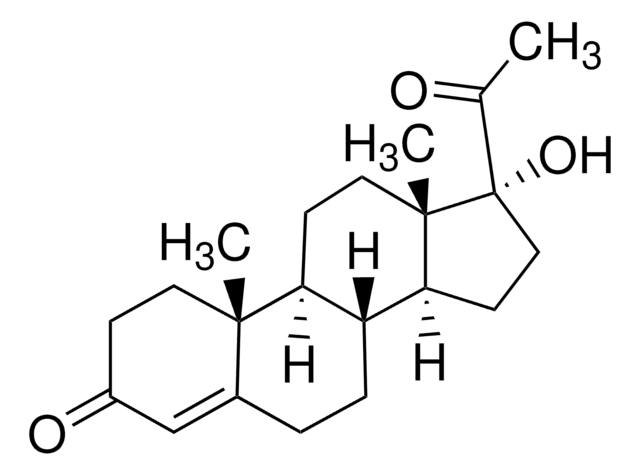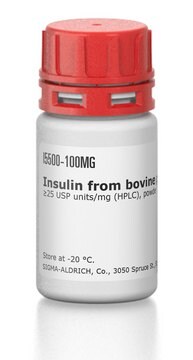すべての画像(3)
About This Item
実験式(ヒル表記法):
C257H383N65O77S6
CAS番号:
分子量:
5807.57
EC Number:
MDL番号:
UNSPSCコード:
12352202
NACRES:
NA.32
おすすめの製品
由来生物
human
リコンビナント
expressed in yeast (proprietary host)
無菌性
non-sterile
アッセイ
≥98% (HPLC)
フォーム
powder
有効性
≥27.5 units/mg (dried basis)
テクニック
cell culture | mammalian: suitable
溶解性
0.01 M HCl: 20 mg/mL, clear, colorless
UniProtアクセッション番号
輸送温度
ambient
保管温度
−20°C
InChI Key
PBGKTOXHQIOBKM-FHFVDXKLSA-N
遺伝子情報
human ... INS(3630)
類似した製品をお探しですか? 訪問 製品比較ガイド
アプリケーション
ヒトインスリンは、以下の目的で使用されています:
- ASC(脂肪由来幹細胞)の脂肪生成に必要な培地で
- ラットの若い脳と加齢脳におけるインシュリンの効果を研究するために。
- マウスモデルを用いてプロテアーゼ活性化受容体2(PAR2)の炎症作用に及ぼすインスリンの効果を研究するために。
生物化学的/生理学的作用
インスリンは、グルコ-ス、アミノ酸や脂肪酸の細胞内への取り込み、利用および貯蔵を調節し、グリコ-ゲン、タンパク質および脂肪の分解を阻害します。
膵島のβ細胞で産生される2本鎖ポリペプチドホルモンです。分子量は約5800 Daです。α鎖とβ鎖は、2本の鎖間ジスルフィド結合を解して連結しています。α鎖には、鎖内ジスルフィド結合が存在します。インスリンは、グルコ-ス、アミノ酸や脂肪酸の細胞内への取り込み、利用および貯蔵を調節し、グリコ-ゲン、タンパク質および脂肪の分解を阻害します。
その他情報
InChI: 1S/C257H383N65O77S6/c1-29-131(23)205(313-193(339)104-259)252(393)317-204(130(21)22)248(389)288-159(75-82-200(349)350)217(358)282-156(71-78-189(263)335)221(362)308-183-116-403-404-117-184-243(384)305-178(111-324)240(381)294-162(88-123(7)8)225(366)295-168(95-140-53-61-146(329)62-54-140)228(369)283-154(69-76-187(261)333)218(359)290-161(87-122(5)6)223(364)285-158(74-81-199(347)348)220(361)302-174(101-190(264)336)235(376)298-170(97-142-57-65-148(331)66-58-142)231(372)309-182(242(383)304-176(255(396)397)103-192(266)338)115-402-401-114-181(214(355)273-107-194(340)278-153(72-79-197(343)344)216(357)281-151(51-42-84-271-257(267)268)212(353)272-108-195(341)279-166(93-138-46-36-32-37-47-138)227(368)297-167(94-139-48-38-33-39-49-139)230(371)299-171(98-143-59-67-149(332)68-60-143)238(379)320-208(135(27)327)254(395)322-85-43-52-186(322)246(387)286-152(50-40-41-83-258)222(363)321-209(136(28)328)256(398)399)311-250(391)203(129(19)20)316-236(377)164(90-125(11)12)292-229(370)169(96-141-55-63-147(330)64-56-141)296-224(365)160(86-121(3)4)289-210(351)133(25)277-215(356)157(73-80-198(345)346)287-247(388)202(128(17)18)315-237(378)165(91-126(13)14)293-233(374)173(100-145-106-270-120-276-145)301-239(380)177(110-323)280-196(342)109-274-213(354)180(113-400-405-118-185(310-244(183)385)245(386)319-207(134(26)326)253(394)306-179(112-325)241(382)318-206(132(24)30-2)251(392)312-184)307-226(367)163(89-124(9)10)291-232(373)172(99-144-105-269-119-275-144)300-219(360)155(70-77-188(262)334)284-234(375)175(102-191(265)337)303-249(390)201(127(15)16)314-211(352)150(260)92-137-44-34-31-35-45-137/h31-39,44-49,53-68,105-106,119-136,150-186,201-209,323-332H,29-30,40-43,50-52,69-104,107-118,258-260H2,1-28H3,(H2,261,333)(H2,262,334)(H2,263,335)(H2,264,336)(H2,265,337)(H2,266,338)(H,269,275)(H,270,276)(H,272,353)(H,273,355)(H,274,354)(H,277,356)(H,278,340)(H,279,341)(H,280,342)(H,281,357)(H,282,358)(H,283,369)(H,284,375)(H,285,364)(H,286,387)(H,287,388)(H,288,389)(H,289,351)(H,290,359)(H,291,373)(H,292,370)(H,293,374)(H,294,381)(H,295,366)(H,296,365)(H,297,368)(H,298,376)(H,299,371)(H,300,360)(H,301,380)(H,302,361)(H,303,390)(H,304,383)(H,305,384)(H,306,394)(H,307,367)(H,308,362)(H,309,372)(H,310,385)(H,311,391)(H,312,392)(H,313,339)(H,314,352)(H,315,378)(H,316,377)(H,317,393)(H,318,382)(H,319,386)(H,320,379)(H,321,363)(H,343,344)(H,345,346)(H,347,348)(H,349,350)(H,396,397)(H,398,399)(H4,267,268,271)/t131-,132-,133-,134+,135+,136+,150-,151-,152-,153-,154-,155-,156-,157-,158-,159-,160-,161-,162-,163-,164-,165-,166-,167-,168-,169-,170-,171-,172-,173-,174-,175-,176-,177-,178-,179-,180-,181-,182-,183-,184-,185-,186-,201-,202-,203-,204-,205-,206-,207-,208-,209-/m0/s1
調製ノート
本製品は、0.01 M HCL 20 mg/mL で可溶化できます。可溶化後、ストック溶液は、単回使用分ごとに -20 ℃ で長期保存が可能です。凍結-解凍サイクルは避けてください。
関連製品
製品番号
詳細
価格
保管分類コード
11 - Combustible Solids
WGK
nwg
引火点(°F)
Not applicable
引火点(℃)
Not applicable
個人用保護具 (PPE)
Eyeshields, Gloves, type N95 (US)
適用法令
試験研究用途を考慮した関連法令を主に挙げております。化学物質以外については、一部の情報のみ提供しています。 製品を安全かつ合法的に使用することは、使用者の義務です。最新情報により修正される場合があります。WEBの反映には時間を要することがあるため、適宜SDSをご参照ください。
Jan Code
2509060:
I2643-50MG:
I2643-VAR:
I2643-BULK:
I2643-25MG:
I2643-250MG:
この製品を見ている人はこちらもチェック
Shüné V Oliver et al.
PloS one, 12(7), e0180909-e0180909 (2017-07-13)
Exogenous vertebrate-derived factors circulating in the blood have the capacity to modulate the biology of haematophagous insects. These include insulin, insulin growth factor 1 (IGF) and transforming growth factor β1 (TGFβ). The effects of the consumption of these three proteins
Theresia Gutmann et al.
The Journal of cell biology, 217(5), 1643-1649 (2018-02-18)
Insulin receptor (IR) signaling plays a critical role in the regulation of metabolism and growth in multicellular organisms. IRs are unique among receptor tyrosine kinases in that they exist exclusively as covalent (αβ)2 homodimers at the cell surface. Transmembrane signaling
Linda Adzovic et al.
Journal of neuroinflammation, 12, 63-63 (2015-04-19)
The role of insulin in the brain is still not completely understood. In the periphery, insulin can decrease inflammation induced by lipopolysaccharide (LPS); however, whether insulin can reduce inflammation within the brain is unknown. Experiments administrating intranasal insulin to young
Eric Hyun et al.
Journal of immunology (Baltimore, Md. : 1950), 184(5), 2702-2709 (2010-02-02)
Given the anti-inflammatory effects of insulin in human and animal studies done in vivo and given the signaling pathways in common between insulin and the protease-activated receptor 2 (PAR(2)), a G protein-coupled receptor, we hypothesized that insulin would have an
Armelle Corpet et al.
The EMBO journal, 30(3), 480-493 (2010-12-24)
Mammalian cells possess two isoforms of the histone H3-H4 chaperone anti-silencing function 1 (Asf1), Asf1a and Asf1b. However to date, whether they have individual physiological roles has remained elusive. Here, we aim to elucidate the functional importance of Asf1 isoforms
ライフサイエンス、有機合成、材料科学、クロマトグラフィー、分析など、あらゆる分野の研究に経験のあるメンバーがおります。.
製品に関するお問い合わせはこちら(テクニカルサービス)












